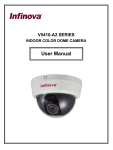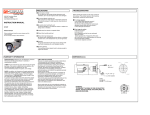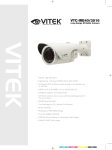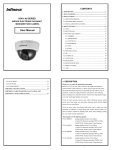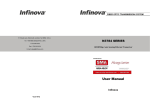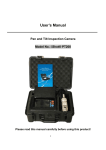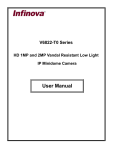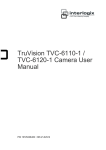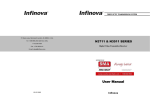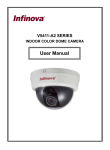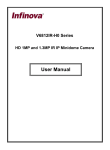Download V5822IR-A3 SERIES User Manual
Transcript
V5822IR-A3 SERIES VANDAL RESISTANT IR FIXED MINIDOME CAMERA User Manual CONTENTS CHAPTER I DESCRIPTION .......................................................................... 1 CHAPTER II MAIN FEATURES ................................................................... 2 CHAPTER III INSTALLATION..................................................................... 3 3.1 SURFACE MOUNTING ......................................................................... 3 3.2 WALL MOUNTING (WITH 86 BOX).................................................... 6 3.3 HANDLING PRECAUTIONS................................................................ 8 3.4 INSTALLATION PRECAUTIONS......................................................... 8 CHAPTER IV CAMERA FUNCTION SETTING ........................................ 9 APPENDIX I SPECIFICATIONS ................................................................. 12 APPENDIX II CABLE DIAMETER CALCULATION AND LIGHTNING & SURGE PROTECTION..................................................... 14 CHAPTER I DESCRIPTION Thank you very much for purchasing our product. Infinova’s V5822IR-A3 series high resolution IR minidome cameras feature a high sensitivity 1/3" SONY Super HAD II CCD sensor. Advanced Digital Signal Processing (DSP) provides 520 TV lines of resolution and authentic images. The built-in IR illuminators with 25 meters of radiant distance provide super imaging performance at nighttime. These cameras are the perfection solution for a 24x7 around-the-clock surveillance. V5822IR-A3 series IR minidome cameras employ vandal resistant minidome housing, making them the ideal choice for the hazardous surveillance environments. The cameras provide easy installation, designed for surface mount with 3-axis adjustment. This manual is for the following models: V5822IR-A3014SE IR minidome camera, 1/3 inch CCD, Vandal-resistant, 3-axis, Day/night, 520TVL, PAL, 12VDC/24VAC, Surface mount, 3.3-12mm vari-focal lens V5822IR-A3004SE IR minidome camera, 1/3 inch CCD, Vandal-resistant, 3-axis, Day/night, 520TVL, NTSC, 12VDC/24VAC, Surface mount, 3.3-12mm vari-focal lens 1 CHAPTER II MAIN FEATURES y 1/3" SONY high resolution Super HAD II CCD sensor y Resolution: 520 TVL y IR-Cut Removable (ICR) Filter for Day/Night switching y Built-in IR illuminators, 850nm wavelength, 25 meters radiant distance y Adjustable power consumption of IR illuminators y Super imaging performance at nighttime y Auto Electronic Shutter (AES), Auto Gain Control (AGC), Backlight Compensation (BLC) y Aspherical, auto-iris, vari-focal lens with IR correction y LEVEL adjustment y Surface Mount, 3-axis adjustment 2 CHAPTER III INSTALLATION 3.1 Surface Mounting Step 1: Prepare mounting holes If the minidome camera’s pigtail is dragged out from the top of upper housing, drill mounting holes at the desired position. See the figure below for the size and location of mounting holes. Ø30.0 Cable hole Ø5 .5 5 13 ° 13 5° 30.0 Ø92.0 Mounting hole (Unit: mm) Figure 3-1 Step 2: Install upper housing Loosen the three mum-head screws in bubble flange and take off the bubble. For ease of installation, upper housing and dome bubble are connected with a safety lanyard. Pay attention to prevent dust, scrapings and the like from falling into the bubble. There are DIP switch, Blemish correction button and three mounting holes in the upper housing. Refer to Chapter IV for detailed operation instruction. Install the upper housing to the desired position with three M4*25 conical tapping screws and then connect the properly arranged cables with external power source and relevant devices. 3 Figure 3-2 Step 3: Adjust viewing angle Check whether the cables are properly and firmly connected before powering on. The dome camera will perform a self-test for about 30 seconds after power-on. Then loosen the locking screw to adjust the camera angle according to your surveillance need. The camera features X, Y, Z 3-axis adjustment. It allows 0°~350° panning adjustment, 0°~75° tilting adjustment and -85°~85° rotating adjustment. Figure 3-3 Step 4: Set camera function You can use the DIP switch in the upper housing to set the desired video quality on site. The detailed instructions are specified in Chapter IV. 4 Step 5: Install dome bubble Install the bubble flange to upper housing. In this process, the shielding cover may block the camera. Thus, before securing the bubble, user should adjust the shielding cover to a proper position. Then, fasten the screws. With all the procedures finished, user should further confirm whether each part of the device is properly and firmly connected. Figure 3-4 Dimensions (Unit: mm) Figure 3-5 5 3.2 Wall Mounting (with 86 box) Step 1: Install the adapter Fix the adapter to an 86 box with two M3.5 countersunk head screws. Figure 3-6 Step 2: Install upper housing Arrange the cables properly. Loosen the three mum-head screws in bubble flange and take off the bubble. For ease of installation, upper housing and dome bubble are connected with a safety lanyard. Secure the camera assembly to the adapter with three M3 conical screws. Pay attention to prevent dust, scrapings and the like from falling into the bubble. Figure 3-7 6 Step 3: Adjust viewing angle Check whether the cables are properly and firmly connected before powering on. The dome camera will perform a self-test for about 30 seconds after power-on. Then loosen the locking screw to adjust the camera angle according to your surveillance need. The camera features X, Y, Z 3-axis adjustment. It allows 0°~350° panning adjustment, 0°~75° tilting adjustment and -85°~85° rotating adjustment. Step 4: Set camera function You can use the DIP switch in the upper housing to set the desired video quality on site. The detailed instructions are specified in Chapter IV. Step 5: Install dome bubble Install the bubble flange to upper housing. In this process, the shielding cover may block the camera. Thus, before securing the bubble, user should adjust the shielding cover to a proper position. Then, fasten the screws. With all the procedures finished, user should further confirm whether each part of the device is properly and firmly connected. Figure 3-8 7 3.3 Handling Precautions 1. Never let any water or liquid flow into this equipment. 2. Please do not directly touch the CCD element. If it is necessary to clean the dome bubble, use a soft cloth moistened with alcohol to wipe off any dust. 3. If any abnormality occurs, make sure to unplug the unit and contact Infinova or your local dealer. 4. This camera possesses AGC circuit. Therefore, when the camera is used under lower luminance, the sensibility will strengthen automatically and make the image very rough in vision. It is normal. 5. If the subject is with high luminance (like lamp), vertical stripes will occur on the monitor (tailing shadow) or the surrounding image becomes vague (flowering). It is special phenomenon of CCD, not error. 6. The power for this camera is 12VDC or 24VAC. The power 24VAC should be isolated power only. 3.4 Installation Precautions 1. Do not drop the camera or subject it to strong knock. 2. Do not point the camera lens toward the sun or other strong light. 3. Do not install the camera in the places where the temperatures rise above or fall below the acceptable range (from -10°C to 50°C), or high humidity and/or direct rainfall, frequent vibrations, or shocks occur. 8 CHAPTER IV CAMERA FUNCTION SETTING In the upper housing, a 6-position DIP switch is used to adjust AGC, AES, BLC, etc. And another button is used to compensate the blemish. See the figure below for the location of the DIP switch and Blemish correction button. DIP switch 1 4 OFF RT 2 3 4 5 6 IR F 1 S AE GH 5 6 5 H L 6 OF F 5 LO W IR W LE 6 MI D 6 VE L 5 LO SMA BLC OF HI HI GH C AG LEV EL OFF 3 2 C AG Blemish correction button Operation Instruction: 1. AGC -- [AGC-HIGH/AGC-LOW Selection] Magnify the signal collected from CCD to an available standard to video amplifier, and how much it magnifies equals to gain, which means the sensitivity. Adjust AGC properly to have camera work under a larger illumination area. AGC-HIGH: Activate AGC-HIGH function. AGC-LOW: Activate AGC-LOW function. Default as: “AGC HIGH”. 2. AES -- Auto Electronic Shutter Selection AES: Activate AES function, and camera automatically modulate the exposure time. OFF: Shut AES function, and the exposure time is constant. Default as: “OFF”. 9 3. BLC -- Backlight Compensation Function When the background of view is pretty bright and objects on front cannot be seen clearly, it needs to use back light compensation function. BLC: Activate BLC function, and then the workstations of AGC, AES, and IRIS confirm the entire view to distinguish the bright background area and the dark front objects. OFF: Shut BLC function. When the contrast between view background and front objects is not big, it will not need to activate back light compensation function. Default as: “OFF”. 4. IR Illuminators Brightness Adjustment SMART IR: Camera smartly modulates the brightness of IR illuminators if it set to “SMART IR”. OFF: Shut. Default as: “SMART IR”. 5. IR Illuminators Power Consumption Adjustment The 5th and 6th positions of the DIP switch are used to set the power consumption of IR illuminators. See the table below for the details. (“0” means the switch is placed to the up-end; “1” means the switch is placed to the down-end. OFF LOW MID HIGH 5 0 0 1 1 6 0 1 0 1 Default as: “MID”. 10 Blemish correction instruction: Pressing Blemish correction button, it can compensate the blemish in CCD, which is caused by long-time work. Note: In order to offer Black Burst to camera, it needs to cover the lens while compensating the blemish. 11 APPENDIX I SPECIFICATIONS Model V5822IR-A3 Image Sensor 1/3" SONY Super HAD II CCD Video System NTSC; PAL Scanning System 2:1interlace scanning Effective Pixels (H×V) NTSC: 768×494, 380K; PAL: 752×582, 440K Resolution 520 TVL Sensitivity Color mode: 0.2 lux @ F1.2 (30 IRE, AGC HIGH); B/W mode: 0 lux (IR ON) Infrared Wavelength 850nm Infrared Radiant Distance 25m S/N Ratio > 48 dB (AGC OFF), Black Burst Lens F1.4, f=3.3~12 mm Camera Angle Adjustment X (Panning): 0°~350°; Y (Tilting): 0°~75°; Z (Rotating): -85°~85° Auto Electronic Shutter OFF: NTSC: 1/60s, PAL:1/50s; ON: NTSC: 1/60~1/100,000s, PAL:1/50~1/100,000s Gamma Correction 0.45 White Balance Auto Color Temperature Range 2400K~9600K Auto Gain Control High/Low Backlight Compensation ON/OFF Sync. System Internal Video Output 1.0 Vp-p (75 Ohm), BNC connector Power Supply 12VDC/24VAC 12 Power Consumption 12VDC: 4.5W; 24VAC: 5W Operating Temperature 14° F ~ 122° F (-10° C ~ 50° C) Storage Temperature -4° F ~ 140° F (-20° C ~ 60° C) Operating Humidity 0~90% RH (non-condensing) Unit Dimensions (H×Ø) 3.7"×5.2" (93mm×132mm) Box Dimensions (L×W×H) 6.9"×6.9"×6.3" (175mm×175mm×160mm) Unit Weight 1.9 lbs. (0.85 kg) Shipping Weight 2.3 lbs. (1.05 kg) Specifications and appearance are subject to change without notice. 13 APPENDIX II CABLE DIAMETER CALCULATION AND LIGHTNING & SURGE PROTECTION Relation between 24VAC Cable Diameter and Transmission Distance In general, the maximum allowable voltage loss rate is 10% for AC-powered devices. The table below shows the relationship between transmission power and maximum transmission distance under a certain specified cable diameter, on condition that the 24VAC voltage loss rate is below 10%. According to the table, if a device rated at 50W is installed 17-meter away from the transformer, the minimum cable diameter shall be 0.8000mm. A lower diameter value tends to cause voltage loss and even system instability. Diameter (mm) Distance (ft / m) Power (W) 0.8000 1.000 1.250 2.000 10 283 (86) 451 (137) 716 (218) 1811 (551) 20 141 (42) 225 (68) 358 (109) 905 (275) 30 94 (28) 150 (45) 238 (72) 603 (183) 40 70 (21) 112 (34) 179 (54) 452 (137) 50 56 (17) 90 (27) 143 (43) 362 (110) 60 47 (14) 75 (22) 119 (36) 301 (91) 70 40 (12) 64 (19) 102 (31) 258 (78) 80 35 (10) 56 (17) 89 (27) 226 (68) 90 31 (9) 50 (15) 79 (24) 201 (61) 100 28 (8) 45 (13) 71 (21) 181 (55) 110 25 (7) 41 (12) 65 (19) 164 (49) 120 23 (7) 37 (11) 59 (17) 150 (45) 130 21 (6) 34 (10) 55 (16) 139 (42) 140 20 (6) 32 (9) 51 (15) 129 (39) 150 18 (5) 30 (9) 47 (14) 120 (36) 160 17 (5) 28 (8) 44 (13) 113 (34) 170 16 (4) 26 (7) 42 (12) 106 (32) 180 15 (4) 25 (7) 39 (11) 100 (30) 190 14 (4) 23 (7) 37 (11) 95 (28) 200 14 (4) 22 (6) 35 (10) 90 (27) 14 Lightning & Surge Protection The product adopts multi-level anti-lightning and anti-surge technology integrated with gas discharge tube, power resistor and TVS tube. The powerful lightning and surge protection barrier effectively avoids product damage caused by various pulse signals with power below 4kV, including instantaneous lightning, surge and static. However, for complicated outdoor environment, refer to instruction below for lightning and surge protection: z The product features with dedicated earth wire, which must be firmly grounded. As for surveillance sites beyond the effective protection scope, it’s necessary to erect independent lightening rods to protect the security devices. It’s recommended to separate the lightning rod from the mounting pole, placing the rod on an independent pole, as shown in the figure below. If the product has to be installed on the same pole or pedestal for lightning rod, there should be strict insulation between the video cable BNC terminal, power cable, control cable and the standing pole of the lightning rod. z For suburb and rural areas, it’s recommended to adopt direct burial for the transmission cables. Overhead wiring is prohibited, because it’s more likely to encounter lightning strike. Use shielded cables or thread the cables through metal tubes for burial, thus to ensure the electric connection to the metal tube. In case it’s difficult to thread the cable through the tube all the way, it’s acceptable to use tube-threaded cables only at both ends of the transmission line, yet the length in burial should be no less than 15 meters. The cable sheath and the tube should be connected to the lightning -proof grounding device. z Additional high-power lightning-proof equipment and lightning rods should be installed for strong thunderstorm or high induced voltage areas (such as high-voltage substation). z The lightning protection and grounding for outdoor devices and wires should be designed in line with the actual protection requirement, national standards and industrial standards. z The system should perform equipotential grounding by streaming, shielding, clamping and earthing. The grounding device must meet anti-interference and electric safety requirements. There should be no short-circuiting or hybrid junction between the device and the strong grid. Make sure there’s a reliable grounding system, with grounding resistance below 4Ω (below 10Ω for high soil resistivity regions). The cross-sectional area of the earthing conductor should be no less than 25mm². LPZOA 30° LPZOB 30° Lightning rod Front device for surveillance system Mounting pole for front device Separated layout for the lightning rod and the standing pole 15 Infinova 51 Stouts Lane, Monmouth Junction, NJ 08852, U.S.A. Tel: 1-888-685-2002 (USA only) 1-732-355-9100 Fax: 1-732-355-9101 [email protected] V1.2 1205


















